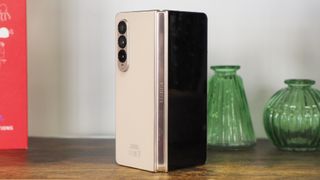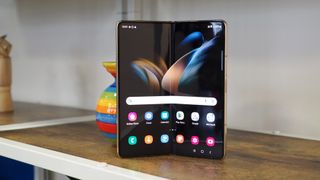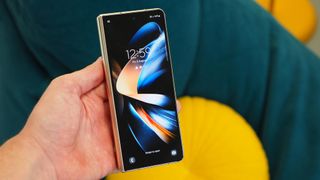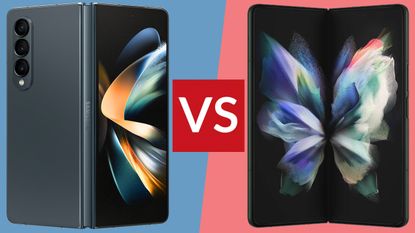The king of the best folding phones is back for 2022: yes, Samsung Galaxy Unpacked has happened for the summer, revealing the Galaxy Z Fold 4 (which I describe as 'the fanciest of foldables' in my early verdict review) and smaller Z Flip 4, among other non-phone arrivals.
I've handled the Z Fold 4 prior to its unveiling, and having lived with the Z Fold 3 for a week upon its launch back in 2021, I'm well placed to highlight the differences between these two foldable flagships. So just how much of a difference does a year make and what can you expect from the Fold 4?
Samsung Galaxy Z Fold 4 vs 3: Price

As ever a product price reveals volumes about it and, unsurprisingly for a massive foldable such as this, the Z Fold 4 is among the priciest of phones you could buy today. It starts at a lofty £1,649/AU$2,499 for the 256GB model, increasing through to £2,019/AU$2,999 for the 1TB model. All options feature 12GB RAM, irrelevant of storage size.
Now, I'm sure you'll agree, that's a lot of money. But you knew that was going to be the case: at launch the Z Fold 3 wasn't exactly much less, arriving on the scene with an asking price from £1,599/AU$2,499. That's the same £50 increment as seen in the clamshell Z Flip 4 versus Z Flip 3, too, though for Australia the prices match.
However, as you can see from the live pricing widget below, the Z Fold 3 has decreased further in price in the year since its launch. Not by a gigantic amount, mind, so you might find that Samsung's pre-order trade-in for the Z Fold 4 is the more appealing option for you.
Galaxy Z Fold 4 vs Fold 3: Design and displays

So what exactly do you get for that extra cash? Well, in short, the Z Fold 4 isn't hugely different to the Z Fold 3: at first glance I struggled to tell the difference, in truth, but there are small yet important tweaks for the newer model.
First thing of note: the diagonal measure of both foldable phones' two screens are one and the same. That means a 6.2-inch exterior display and 6.7-inch interior display. However, and here's the key part, the Z Fold 4 expands its unfolded size (only by 2mm) and, in a moment of near magic, both screens' aspect ratios as a result.
How is this possible? Well, Samsung has redesigned the Z Fold 4's hinge, meaning the unfolded panel can now be wider overall (while the front panel remains the same width, it just has smaller bezel). So the diagonal measure doesn't change, but the new panels present at 25.5:10 on the exterior (not 25:9 as per the Z Fold 3) and a 6:5 on the interior (not 5:4 as per the Z Fold 3). It's a fairly subtle change, partly achieved through the shrinking of bezel, going a small way towards the complaints of the screens being too 'tall' in the earlier model. I think more still needs to be done to offset that assertion though.
If you like the full blow-by-blow spec then I compare the key display details in the bullet point list below:
- Z Fold 4: 6.2-inch front display (904 x 2316 resolution, 25.5:10 aspect)
- Z Fold 3: 6.2-inch front display (832 x 2268 resolution, 24:10 aspect)
- Z Fold 4: 6.7-inch main display (1812 x 2176 resolution, 6:5 aspect)
- Z Fold 3: 6.7-inch main display (1768 x 2208 resolution, 5:4 aspect)
Z Fold 4 vs Z Fold 3: Spec and battery

Otherwise the look and feel of both Galaxy Z Fold 4 and Z Fold 3 are much the same. There's been no battery capacity (4400mAh) or wired charging speed change, for example, with wireless charging getting a minor boost from 11W to 15W between older and newer models.
Within you'll find top-end Qualcomm Snapdragon processors, with the Z Fold 4 obtaining the Snapdragon 8+ Gen 1 chip, the earlier Fold 3 the Snapdragon 888. That's just a sign of the times of release dates, really, as I don't think you'll find major jumps between those two systems. Both are 5G capable too, of course.
The Galaxy Z Fold 4 does also intro updated software courtesy of Google's Android 12L operating system, too, adding a new feature called Taskbar for additional multi-tasking. It doesn't appear as though this will be available on the Z Fold 3, at least certainly not upon its launch.
There's also S Pen stylus compatibility with both models. It's a sold-separately accessory, though, not included or embedded within the Z Fold 4 as was originally rumoured.
Samsung Galaxy Fold 4 vs 3: Cameras

To look at you might think the Z Fold 4's camera arrangement looks like the Z Fold 3's. Design-wise you'd be right, too, as there's a trio of cameras on the rear.
However, the Fold 4 makes a fair few changes: the main camera is 50-megapixels, which is a big boost over the 12MP of the Fold 3; the Fold 4 also expands the zoom to 3x, bettering the 2x of the earlier model; while both the foldables maintain the same 12MP ultra-wide though. Samsung claims the newer model also achieves better optical stabilisation (OIS) too.
When I used the Galaxy Z Fold 3 for some weeks I was at first impressed by the under display camera (UDC) on its main unfolded display. However, after various situations, I found its criss-cross 'mesh' when bright backgrounds were present to be distracting. In the Z Fold 4 that issue hasn't gone away entirely, but the UDC is now the next-generation so this appearance is less pronounced. Still not 'invisible' like I hope for in the future though.
Samsung Galaxy Z Fold 4 vs Fold 3: Verdict
So is the Samsung Galaxy Z Fold 4 that much more worthwhile compared to the earlier Z Fold 3? The summary of each device is fairly similar: both offer the same battery capacity and wired charging, S Pen functionality (if you buy the stylus accessory), a great 6.7-inch unfolded display experience, and multi-tasking abilities.
However, the Z Fold 4 pushes things forward in a few areas: its screen aspect ratios are a smidgen wider and less tall, which is more practical in both folded and unfolded formats; its cameras arrangement takes a bigger leap forward in resolution and zoom terms; its software adds Taskbar for enhanced multi-tasking potential; and there's more power and a minor improvement to wireless charging speeds.
Although the Galaxy Z Fold 4 doesn't reinvent the idea of the folding phone, nor does it surge forward with gigantic breakthroughs, it's a similar-price offering to the Z Fold 3 from a year ago and I think the newer model is clearly the best large-screen foldable you'll find on the market today.



